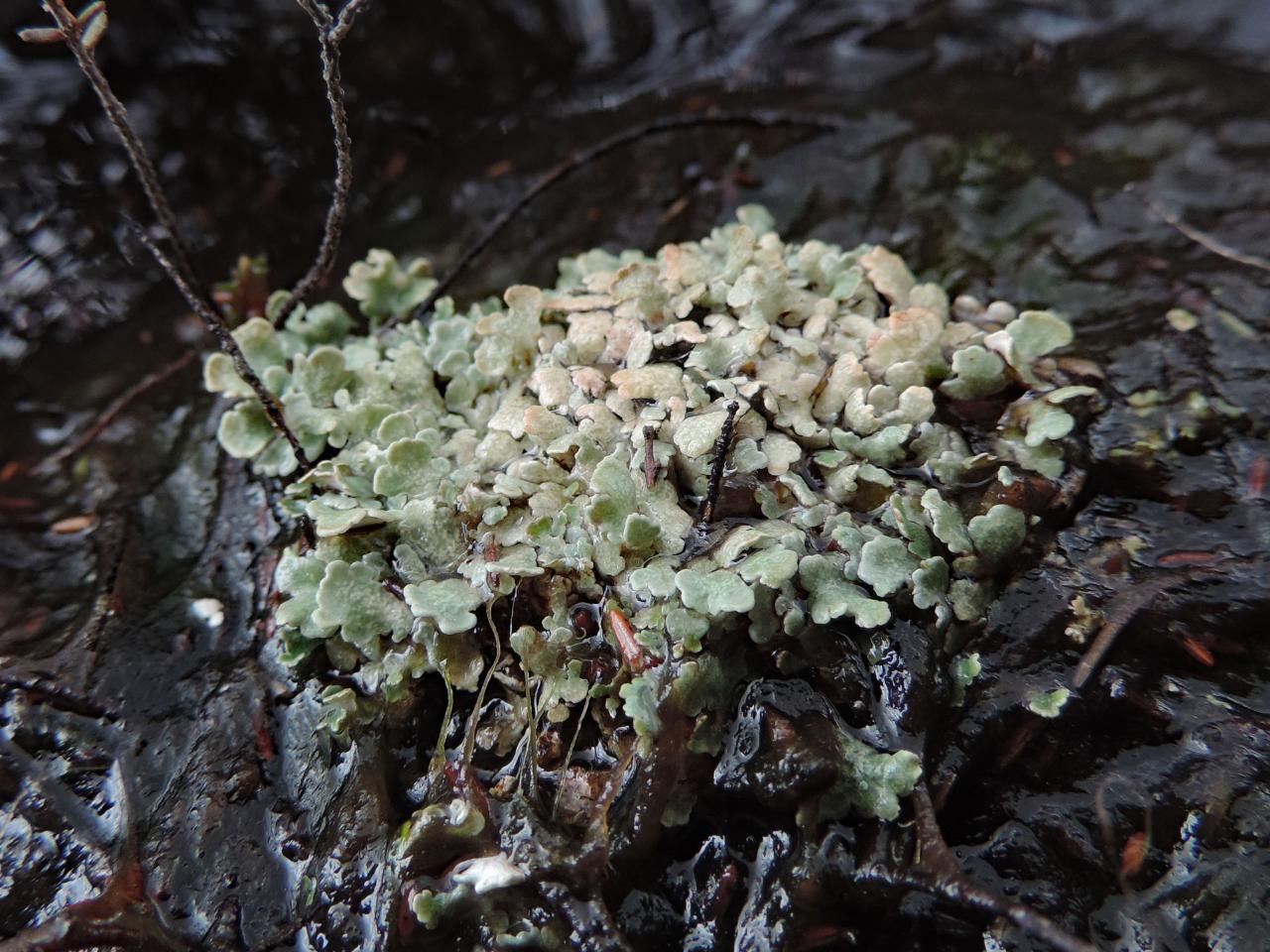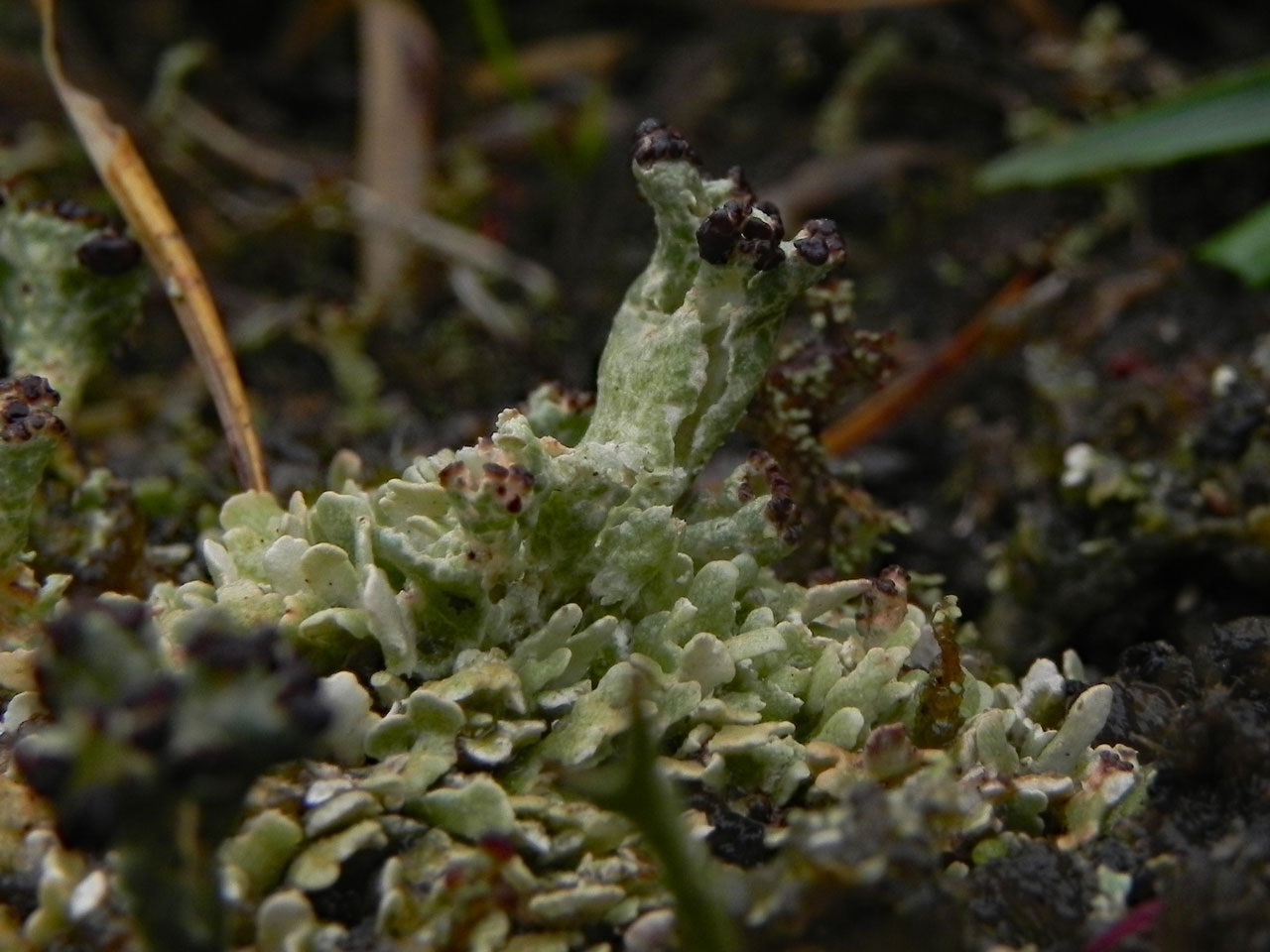Cladonia strepsilis
A large Cladonia, of damp and wet heathland and moorland, mostly occurring as sterile mats of basal squamules, with a distinctive mottled green-bronze colour when dry, pale apple green when wet, rarely with podetia. With a characteristic C + green spot test.
Basal squamules usually dominant, forming cushions of elongate, indented squamules. Upper surface typically a mottled grey-green and brown, giving a beaten rusting bronze effect when dry. When wet the squamules are a more even pale apple green. The undersides are white. Rarely the squamules support delineated heaped solaria; a distinctive feature but not of any apparent taxonomic significance. Podetia infrequent, up to 1cm high, consisting of irregular cylindrical turgid podetia, often squamulose and fissured and with short branches at tips. Apothecia, usually dark brown disks, rarely pale, on the tips of the podetia, often in aggregations.
Reactions: thallus C+ fleeting bright emerald green, K–, KC–, Pd+ yellow, UV+ whitish (baeomycesic and squamatic acids, strepsilin, traces of barbatic and at least three unkown substances).
The combination of cushions of basal squamules of a beaten rusty bronze colour when dry, pale apple green when wet, combined with the fleeting C+ fleeting emerald green reaction is highly distinctive. Be aware that applying C to brown Cladonia squamules results in a persistent dull green colour as the brown colour is removed; not to be confused with the fleeting bright emerald green reaction of Cladonia strepsilis.
On damp to wet very acid humus in moorland and heathlands. Most typically on thin peat over rock or erroded blanket bog in the uplands and in open patches in low productivity wet and humid heath in the lowlands. Recently it was discovered in open patches in lichen rich montane Racomitrium lanuginosum – Carex bigelowii moss heath in the Lake District. Avoids permanently wet peat, but can survive some imersing in temporary flooded pans. Absent from dry sandy heaths. A light demanding species, often dependant on grazing, burning or occasional disturbance to prevent loss to over shading. A highly fire resistant species, which often survives cool fires as whitened squamules, which sprout new green squamules. Like Pycnothelia papillaria, it prefers humus rich soils, typically firm humus and it is absent from both bare mineral soil or loose fibrous humus, so does not benefit in the short term from soil disturbance in lowland heaths. Strong colonisation of features such as WWII gravel pit bases in the New Forest, however, suggests that colonisation will occur if the ground remains open for decades allowing humus development.

Cladonia strepsilis has a distinct British distribution, shared by other heathland species such as Pycnothelia papillaria and Cladonia zopfii. It is frequent in the Scottish Highlands and locally frequent in southern lowland heathland south of the River Thames but rare in the uplands between. Cladonia strepsilis, however, is more frequent in the Lake District and North Wales than these species but it is still very rare in other moorland areas. In these upland areas this is most likely due to the rarity of very low productivity habitats such as the heavily leached and pre glacial soils of the southern heathlands and shallow humus over rock habitats found in other upland areas. Recently a strong decline has been detected in lowland heaths outside of the New Forest, related to a reduction in grazing and a lack of controlled burning of heaths. It is still abundant in the New Forest, where a recent systematic survey recorded Cladonia strepsilis from 73 out of 100 1km grid squares sampled.
In Ireland it is widespread in moorland to the west but rare in the east.
This species is highly threatened across the European lowlands and is listed as Vulnerable in Netherlands and Denmark, and is also suffering a severe decline in lowland England, except in the New Forest. In the New Forest it is still widespread and locally abundant with traditional heathland management providing frequent well lit hard humus surfaces. The main positive factors are extensive but locally heavy range grazing, controlled burning and accidental and occasional soil disturbance. Air pollution is also implicated is some losses but it has been equally lost from clean air areas where traditional management or suitable periodic disturbance has stopped.
Not threatened in the northern uplands but could decline with abandonment of tradition moorland management.
Ahti, T. & Stenros (2013) Cladonia. In: Nordic Lichen Flora, Volume 5 Cladoniaceae (ed. T. Ahti, S. Stenros & R. Moberg) 8-86. Uppsala: University of Uppsala.
Aptroot, A., van Herk, K. & Sparrius, L. (2011) Korstmossen van Duin, Heide en Stuifzand. Bryologische en Lichenologische Werkgroep van de KNNV
James, P. W. (2009) Cladonia P. Browne (1756). In: The Lichens of Britain and Ireland (C. W. Smith, A. Aptroot, B. J. Coppins, A. Fletcher, O. L. Gilbert, P.W. James & P. A. Wolseley, eds): 309 – 338. London: British Lichen Society.
Sanderson, N. A. (2016) The New Forest Heathland Lichen Survey 2011 – 2015. A report by Botanical Survey & Assessment to Natural England, Forest Enterprise & The National Trust. Link.
Text by Neil A Sanderson, based on James (2009)









